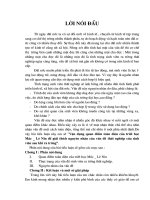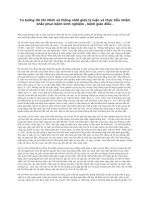Rip Van Winkle
Bạn đang xem bản rút gọn của tài liệu. Xem và tải ngay bản đầy đủ của tài liệu tại đây (47.08 KB, 2 trang )
<span class='text_page_counter'>(1)</span><div class='page_container' data-page=1>
“Rip Van Winkle" is a short story–one of America's most beloved–based on German folk tales.
<b>Themes</b>
Change With Continuity and Preservation of Tradition Với thay đổi liên tục và Bảo tồn Truyền thống
After Rip awakens from his long sleep and returns to the village, he does not recognize the people
he encounters. But not only their faces are new but also their fashions and the look of the village: It
is larger, with rows of houses he had never seen. His own house is in a shambles now with no one
living in it, and the inn he frequented is a hotel. His wife and old Vedder are dead. Others left the
village and never came back. Everything is different, it seems; nothing is as it was. There has even
been a revolutionary war in which America gained its independence from England and became a
new country. However, when Rip looks beyond the village, he sees that the Hudson River and the
Catskill Mountains are exactly the same as they were before his sleep. He also begins to encounter
people who knew him long ago: first, the old woman, then the old man, Peter Vanderdonk, who
testifies to the truth of Rip’s strange tale about the ninepin bowlers he met in the mountains. At this
point in the story, Irving’s main theme begins to emerge: Although wrenching, radical changes are
sometimes necessary to move society forward, such changes must not eradicate old ways and
traditions entirely. Real, lasting change is an amalgam of the old and new. New builds on the
foundations of the old. There must be continuity. So it is that old Vanderdonk, in confirming Rip’s
tale, says he himself has heard the thunder of ninepin bowlers, who are the crewmen of The
<i>Half-Moon, the ship Henry Hudson captained in his exploration of the Hudson River. It seems that their</i>
spirits return to the Hudson Valley and Catskill Mountains every twenty years to keep a “guardian
eye” on the river and its environs. Hudson was an Englishman, yes, but his association with his
overthrown country does not mean the values he represents must die with the revolution. Rip also
sees his son, Rip II, now a grown man, who looks just like him, and is reunited with his daughter,
now a grown woman, who is holding an infant–Rip III. Thus, though, change has come to the
village, their remain links with the past; there is continuity. New generations come along that bring
change, but old values and traditions–as well as family lines–remain alive and thriving. And, every
now and then, thunder rumbles in the Catskills when Hudson and his crew play ninepins.
The Magic of the Imagination
Irving’s story suggests that human imagination can can give society charming, humorous stories
that become part of an enduring, magical folklore. Today, the Catskill and Hudson Valley regions
well remember Rip Van Winkle and Ichabod Crane–the hero of another Irving story, “The Legend of
Sleepy Hollow”–as if they were real persons. A bridge across the Hudson has even been named
after Rip. Sunnyside, Irving’s Tarrytown home between 1835 and 1859, is a major tourist attraction
in the Hudson Valley.
<b>Climax</b>
The climax of the story occurs when the townspeople recognize Rip after he returns to his village.
Analysis
“Rip Van Winkle” is one of the most famous stories of The Sketchbook of Geoffrey Crayon. It is one
of the few that take place in America, although it is believed to be a retelling of an Old World
folktale. The setting of the tale, in the Catskills by the Hudson, gives the story a fairly precise
location that grounds it in America.
The passages that begin and end the story frame it to separate it from the other sketches. Here our
narrator is no longer Crayon but Diedrich Knickerbocker, who is quite adamant in vouching for the
authenticity of the tale, which serves not to satisfy the reader but instead to make the reliability of
the tale and its narrator even more ambiguous. This distance of Crayon from the tale touches on
the theme of veracity in storytelling and its importance.
The story itself is an escapist fantasy; Rip Van Winkle is an ineffectual male hero who cannot
support his farm or family. Instead of facing the consequences of his idleness and facing his wife,
who certainly makes the problem worse instead of better, he sleeps for twenty years. Finally, he is
of such an age that his idleness is excusable and allowed. This makes him an antithesis to the
American dream. He has no ambition, he does not work hard for himself, and he does not rise
above where he began. He just likes to chat and have friends.
</div>
<span class='text_page_counter'>(2)</span><div class='page_container' data-page=2>
Dutch settlers, in their relatively old village, can retell. The story also shows that great historical
events are often less important than the daily happenings in an individual’s life. The only oppressor
Rip Van Winkle cares about having overcome is his wife.
Dame Van Winkle is certainly the antagonist in this story. She is constantly berating Rip Van
Winkle, whom everyone else in the neighborhood adores. She is a completely flat character—we
only ever see her worst side, except for the one comment made after she has died that she always
kept the house in good order. Her criticism of her husband, if far too strong, is nevertheless
deserved. He has completely failed in his role as husband, father, and breadwinner, leaving his
family in near ruin. The husband is an extreme form of deadbeat and the wife an extreme form of
nagging and henpecking, a state of affairs which appears to be a lesson and warning for Irving’s
male and female readers alike. The husbands should learn to be more industrious and attentive,
and the wives should learn to be less antagonistic and more understanding lest they drive their
husbands further away.
Rip’s night in the woods symbolizes the fantasy of escape through one’s imagination, which is in
itself a form of storytelling. Once he is freed of his duties to his family, he becomes the town
storyteller, and it is this story which has freed him from his domestic duties—he literally and
figuratively dreamed them away. In this way the imagination, or one’s creative life, is presented as
a way to deal with the less pleasing duties of everyday life. At the same time, it is not without its
dangers. Although Van Winkle finds a happy ending, he is very close to being labeled insane or
dangerous and being thrust out of the town.
<b>How does “Rip Van Winkle” deal with what became named "the American Dream"?</b>
The protagonist of “Rip Van Winkle” seems completely antithetical to the American work ethic that
is said to make Americans work toward the American Dream of prosperity, the possibility of raising
oneself above where one was born through hard work. Rip instead loses much of what his family
worked for, through pure indolence, and he shows absolutely no ambition, except an ambition to do
nothing as long as he can. This life ends up working out for Rip, but the morality of the tale does
not condone it, for Rip only ends up in better straits with the help of magic, which makes him sleep
through his working years long enough to enjoy his undeserved retirement. In this way he is an
American anti-hero who enjoys the American fantasy of a life of leisure, not the American Dream.
<b>Explain how Rip Van Winkle can be seen as a parallel to Crayon.</b>
Rip Van Winkle is the extreme portrayal of an indolent man, a man who escapes from life in his
imagination, and who has no responsibility. Because he is such an extreme figure, he is only able to
maintain this lifestyle through supernatural means. Crayon is similar in that he has a highly
dominant imaginative life which often gives him a means of escape and little responsibility, but not
nearly to the same extreme. After all, Crayon has a great deal of leisure time as he travels. Since
Crayon does something useful with his time, however, and can distinguish between fiction and
reality, in Crayon we can see the positive side of the imaginative, leisured life.
<b>Thesis Statement / Essay Topic #2: The Passivity of Rip Van Winkle</b>
</div>
<!--links-->
chuoi cung ung RAT van duc.doc
- 11
- 990
- 14


